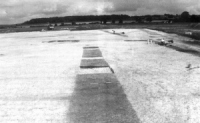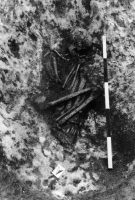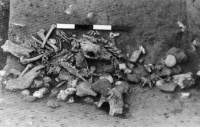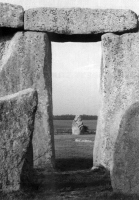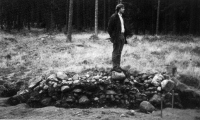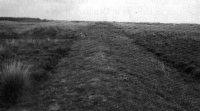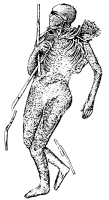|
|
|
|
Editorial Free Student Study Tour Place English Heritage Stonehenge Proposals Rock Art and Shamanism Le Petit Sorcier The Sorcier: A More Recent Tracing Prehistoric Field Systems in North West Europe 'Of Artefacts and Monuments' The Society's Tour of Dumfries and Galloway: Part Two Bog Bodies, Sacred Sites and Wetland Archaeology Champion's Choice Conferences and Exhibitions
|
|
|
|
|
Members will notice that there are fewer illustrations in this issue of PAST. This is partly due to the nature of the articles; but could I please ask the photographers amongst you to take photos of Society events such as one-day meetings and study tours, and make them available for publication so that we can achieve a more visually interesting balance between text and picture. The AP on the front of PAST 30 was unfortunately printed upside down (corrected in the online version). This was because it had been moved from elsewhere in the text (where it was the right way up!) to the front page and the second set of faxed proofs sent to me by the printers were too dark to spot the inadvertent inversion. Many apologies to Bob Bewley, who has had to explain the apparent invisibility of the long gazelle-guiding walls to enquirers! An excess of material submitted for this issue has meant the curtailment of our Champion's Choice section, and the holding over of an interesting review article from Andrew Lawson until the next issue. So if you want to know his thoughts about what people want from books about archaeology, you will have to make a date with the July issue, where we hope also to have the promised further news about Prehistoric Society merchandise.
|
|
|
|
|
There is still a free student place available on the Society's Study Tour to southern Sweden, 14-21 June 1999. If you are a student member of the Society and would like to participate in this terrific tour of prehistoric sites (from megaliths to rock art) in south and east Scania, please contact the Secretary Bob Bewley for further details.
|
| 1. | The Society supports the initiative taken by both English Heritage and the National Trust to improve visitor access and awareness of Stonehenge in a landscape setting by closing the current visitor facilities and the A344 road, proposing a Visitor Centre outside the World Heritage site, building a tunnel for the A303 (as a dual carriageway) and allowing free access to the landscape. | 2. | The UK government and its advisers should be congratulated on aiming for the highest possible standards in the presentation of World Heritage Sites and the standards set at Stonehenge should be exemplary. These standards should include minimising damage to existing and well preserved archaeological sites and minimising the impact on the landscape of any construction works planned. The Society supports the principle of minimal risk to any protected ancient monument. | 3. | The Society believes it is essential that there should be an independent assessment of the cost of a long-bored tunnel to act as a comparison for the proposed cut-and-cover tunnel. The destruction of 13.5 hectares of the most archaeologically sensitive land surface of Europe, within a World Heritage Site, may be something which future generations will find hard to understand. | 4. | The implications of the proposed new road schemes within the World Heritage Site will also have considerable impact on towns and villages outside the WHS and the Society would welcome further consultation on these schemes. | 5. | The detailed proposals for the Visitor Centre (both as a concept and in detail) have yet to be announced and they are an integral part of the future for Stonehenge, not least because of the need for a drop-off point at Fargo, changes to Byway 12 and other boundary changes. The Society would welcome further consultation of the Management Plan as it develops, in particular over provisions for visitor management. | 6. | The future for Stonehenge has to be seen in a very long-term context so that future generations will not have to make further dramatic alterations to a very sensitive landscape. Short-term requirements and aspirations (including costs) have to be weighed against these long-term expectations. The Society would welcome an open debate on the options being discussed for the new Visitor Centre and the ways in which these (and the road proposals) might be funded.
|
|
Bob Bewley Secretary
|
|
LE
PETIT SORCIER
|
|
| Not having seen the original engraving, we felt
unable to comment on the original article in PAST
28 on the "Petit Sorcier" of Trois Frères; however, the contributions
from Anne Sieveking and Michael Eastham have broadened the debate and
enabled us to review some of the issues. It is clear; as Anne Sieveking states, that it is important not to rely on a single interpretation of a particular work, and it should be recognised, when referring to drawings, that there is a Breuil "style" which can at times be misleading in itself. With these points in mind we carried out a search of our bookshelf, concentrating mainly on those works referred to by these two contributors. This resulted in the following: |
1. | A black and white photograph of the entire figure in Geidon, fig. 338. | 2. | A colour photograph of the figure's head in Bahn and Vertut, fig. 104. | 3. | A drawing of the figure, presumably by the author, showing some additional detail of the surrounding engravings and rock features; Geidon fig. 338. | 4. | A number of copies of Breuil's drawing of the figure with varying degrees of additional detail: a) Breuil fig. 129: showing all the engraved marks on the panel but no natural features, black on white. b) Sievekiug fig.6: a copy of 4a to a smaller scale, white on black. c) Breuil fig.139: a detail from 4a at a larger scale and showing a little more detail by use of differential greyscales. d) Geidon fig. 338: the figure and a selection of two animal figures, ignoring all others. e) Bahn and Vertut fig. 104: the figure in isolation. |
|
Without intending to enter any debate upon "meaning" we then attempted to ascertain what, if any, evidence there was to enable conclusions to be drawn about the figure's orientation and its relationship with the "bow".
|
|
THE
SORCIER: A MORE RECENT TRACING
|
|
| The article in PAST
28 by Demouche, Slimak and Deflandre about a new interpretation for
"Petit Sorcier" in Trois-Frères seems to have raised a lot of interest
and many comments lately, by Ann Sieveking, Michael Eastham, Paul Bahn,
Graham Mullan and Linda Wilson. All your commentators insist on the fact
that any theory based on Breuil's tracings should be considered in relation
to the original engravings. None of them seems to be aware that this was
done years ago by Mr. Michel Dauvois, who checked Breuil's tracing by
comparing it to available photographs (published or unpublished, the latter
provided by Count Robert Bégouën) and by a comparison on the spot. He
wrote (my translation) : "The examination of that engraving on the spot, thanks to the extreme kindness of Count Robert Bégouën, shows that the tracing by Breuil gives a more bovine profile to the lower face without showing the mouth even though the engraving is particularly clear: the horned head has got a closed mouth and a nostril where the extremity of the instrument is engaged (...). If the general outline of the body and the legs are perfectly clear; it is a different proposition for what has been construed as arms. However; it is excessively difficult - on a wall with hundreds of figures where thousands of sometimes very faint lines overlap each other - to know exactly what belongs to which figure and, as is so often the case in wall art, some details appear ambiguous next to others which are quite explicit." (Dauvois 1994:176). |
 The Trois-Frères "Petit Sorcier". Drawing by Dauvois (1994, fig.7) |
|
In addition, Dauvois published a rendering of the "Petit Sorcier" (Dauvois 1994:169, fig. 7), which, to the best of my knowledge, is the only reliable tracing (from photographs and direct examination) ever published since Breuil's. Dauvois did not express any doubts as to the standing posture of the "Petit Sorcier" nor as to the two lines issuing from its nose being a musical bow that he interpreted as a "nose flute". As far as I am concerned, I am not convinced by the suggestion that the image should be seen on all fours in the manner of a traditional hunter. I have seen and examined the "Petit Sorcier" in Les Trois-Frères many times. It is located on the left side of the Sanctuary, in a narrow and low passage where one must see it sitting or reclining. Nothing - i.e. neither the morphology of the wall nor the posture of the artist - obliged the Magdalenian who engraved it to represent it standing if what had been meant was the representation of a hunter crouching or on all fours. One may add that in the Sanctuary, as in many other painted and engraved caves (Leroi-Gourham 1972-1973:345-346), the subjects represented are mostly seen as if there were a virtual ground line i.e. in a "natural" posture. This is in particular the case for the animals engraved in the immediate vicinity of the "Petit Sorcier". Therefore I see no reason to postulate that he should be seen in a different posture from the one chosen by the artist who represented him. As to the lines issuing from his nose, they certainly do not look like nose-bleed and the hypothesis of a nasal flute mentioned by Dauvois in the caption to his drawing would be more plausible.
|
|
|
THE
SOCIETY'S TOUR OF DUMFRIES AND GALLOWAY: PART TWO
|
|
| Along with the exciting visits to
the many archaeological sites of the Dumfries and Galloway region (see
PAST 30), the Society was also
honoured with visits to two of the region's museums in Dumfries and Kirkcudbright.
Both had put on prehistoric archaeology exhibitions in our honour. The Dumfries Museum visit on the Monday included a wine and nibbles reception hosted by the Museum staff and the local Dumfriesshire and Galloway Natural History and Archaeological Society. The museum is absolutely delightful with a wide range of exhibits ranging from dinosaur footprints through to an excellent collection of Pictish stones and rock art. The museum's educator had been running local workshops with schools and had planned one on prehistoric life to coincide with our visit: the children's artwork was on display when we visited and included many beautifully drawn views of prehistoric domesticity and models of how pots were made. Many DGNHAS members were present for us to talk to at the reception, and they had a stand at the museum, where many of our members were able to purchase the relevant reports on the sites they had seen; some of the local society members also took up the Prehistoric Society's offer to attend parts of the tour as guests, and thanked the Prehistoric Society for their hospitality (both at the reception and in their annual report). The second visit was to the Stewartry Museum in Kirkcudbright, where we were welcomed to the Museum by Dr. David Devereux. After his informative short talk, members of the Society looked around the museum which contained a varied collection including Jessie M King illustrations and various archaeological artefacts. The Museum had put on a special exhibition of 'Prehistoric Galloway', timed to coincide with our visit. The exhibition contained several choice examples of axes etc. and included excellent photographs of many of the sites we had seen. Both visits were greatly appreciated by all those on the tour and our thanks must go to all concerned with organising the events: members of the DGNHAS, in particular Mark White; Marion Stewart for organising the Dumfries Museum reception; and the staff at the Stewartry Museum, especially Dr David Devereux.
|
|
CHAMPION'S
CHOICE
|
|||||||||||||||||||
|
The Prehistoric Society: Yes, the Society's Web pages are now
available to visitors, thanks to the excellent work of Dr Andrew Garner.
Here you will find details of the Society, membership, events, grants
and awards, the full text of issues of PAST
since April 1997, the Index of the Proceedings
from Vol. 56-60, and Contents and Abstracts for Vols 63-64 (1997-8).
We are sure you will enjoy browsing our excellent website.
| |||||||||||||||||||
|
|
|||||||||||||||||||
|
Iron Age Research Student Seminar: 5.6.99
|
|||||||||||||||||||
 |
The Prehistoric Society Home Page |
